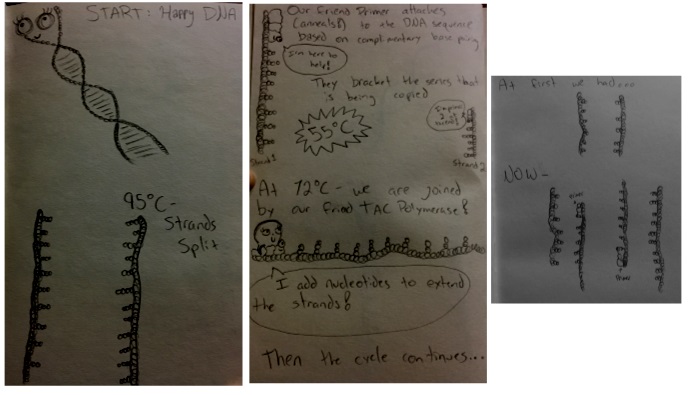BME100 f2016:Group6 W8AM L4
| Home People Lab Write-Up 1 | Lab Write-Up 2 | Lab Write-Up 3 Lab Write-Up 4 | Lab Write-Up 5 | Lab Write-Up 6 Course Logistics For Instructors Photos Wiki Editing Help | |||||||||||||||||||||||||||||||||
|
OUR TEAM
LAB 4 WRITE-UPProtocolMaterials
HEATED LID: 100°C INITIAL STEP: 95°C for 2 minutes NUMBER OF CYCLES: 25
FINAL STEP:72°C for 2 minutes FINAL HOLD: 4°C
Research and DevelopmentPCR - The Underlying Technology Functions of components in a PCR reaction: During the PCR reaction one strand of the DNA acts as the template, guideline, for producing a complimentary strand of DNA. The primers then match to the beginning and end of the DNA sequence that is going to be replicated. The Taq polymerase, an enzyme, finds and attaches itself to a primer and then pairs the complimentary deoxyribonucleotides to the DNA strand. The deoxyribonucleotides (dNTP's) are the individual components that build DNA sequences, such as adenine, thymine, cytosine and guanine. Once the deoxyribonucleotides pair with their compliments on the DNA template, the template DNA is transformed into a completely replicated DNA sequence. PCR steps: The Polymerase Chain Reaction (PCR) is a technique used to generate copies of a single strand of DNA, requiring a test tube, a few reagents and a source of heat. During the initial step, which lasts 3 minutes and occurs at 95°C, the double helix structure of DNA prepares and begins to separate to create two single-stranded DNA templates. During the next 30 seconds, at the same temperature, the DNA strands completely separate during the denature step and move further away from each other. Immediately following the separation of the DNA strand, for 30 seconds at 57°C, the primers attach to each strand of template DNA at the beginning and end of the sequence which is going to be replicated. During the anneal, the step in which the primers attach to the template DNA, the primers must attach before the single stranded DNA templates can pair up again. The next step, extend, is held at 72°C and occurs during the next 30 secs. During this time, the Taq polymerase, an enzyme, attaches to the primers and adds complimentary deoxyribonucleotides to the template DNA strand. In the final step, which continues for 3 minutes at 72°C, the Taq polymerase continues to pair the nucleotides with their compliments on the DNA template until the enzyme detects the second primer, stopping replication. During the final hold, which occurs at 4°C, replication is completed and the new strands are cooled to prevent them from splitting prior to the start of the next replication cycle. Base Pairing: The four molecules, called nucleotides, which make up DNA are Adenine (A), Thymine (T), Cytosine (C) and Guanine (G). Through hydrogen bonding, each nucleotide is able to stick to its complimentary nucleotide in a process known as base-pairing. The base-pairs are A-T, T-A, C-G, and G-C. During thermal cycling, base-pairing occurs during the anneal and extend steps. In the anneal step, the primer must use base-pairing to correctly identify where to attach within the DNA sequence. Once the taq polymerase has attached to the primer, the primer and polymerase must use base-pairing to pair nucleotides with their complimentary nucleotides on the template DNA. Once the primer and polymerase reach the second primer, there is no longer a need for base-pairing and the extend step is finished. SNP Information & Primer DesignBackground: About the Disease SNP Single Nucleotide Polymorphism (SNP) is the variation of a single nucleotide in a specific DNA sequence. A SNP can have very severe effects on the central dogma of a cell, disrupting the production of the correct protein needed for a specific cellular process. In this particular investigation the SNP being looked at is rs35530544, which is associated with several different heart conditions including bradycardia, sinus arrhythmia and other complications that can lead to sudden death. This particular SNP is located in the ANK 2 gene within chromosome 4 in humans. With the SNP, rs35530544, the single nucleotide cytosine is replaced with adenine creating the codon ATC instead of the normal CTC. This replacement causes affects the protein produced. Primer Design and Testing Using the National Center of Biotechnology (NCBI) database online it was possible to search for the SNP rs35530544. The database provided a lot of useful and important information regarding the SNP including the location, the organism it is found in, the chromosome as well as other useful information that can help design the appropriate primer. A DNA primer is a short strand of DNA that is needed for DNA replication. Primers initiate the DNA replication process by providing some of the nucleotides necessary for the process to begin. The database allows you to zoom in the particular section where the SNP is located and even shows the nucleotides associated with the surrounding area of the SNP. This tool was very useful in designing the forward and reverse primers as well as the disease primers. After designing the primers by using the NCBI database the primers were verified on UCSC In-Silico PCR website. The non disease primers coded and worked on the UCSC In-Silico PCR website because it is known sequence while the disease primers did not because of the mutation within the DNA sequence.
| |||||||||||||||||||||||||||||||||







